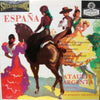



Espana - Rimsky-Korsakov, Granados, Chabrier, Moszkowski - Ataúlfo Argenta (2LP, 45 tours)
ORDER LIMITED TO ONE ITEM PER CUSTOMER
Nikolai Andreyevich Rimsky-Korsakov - Capriccio espagnol
Pantaleón Enrique Joaquín Granados Campiña - “Andaluza” Danza española No. 5
Emmanuel Chabrier - “España”
Moritz Moszkowski - Spanish Dances Book 1
The London Symphony Orchestra conducted by Ataúlfo Argenta
2 LP, Deluxe Laminated Double Gatefold Jackets
Limited to 2,500 numbered copies
Original analog Master tape : YES
Heavy Press : 180g
Record color : black
Speed : 45 RPM
Size : 12'’
Stereo
Studio
Record Press : RTI
Label : Original Recordings Group (ORG)
Original Label : Decca
Recording: December 1956 and January 1957, Kingsway Hall, London by Gordon Parry
Producted by Erik Smith
Mastered by Bernie Grundman
Originally released in 1957
Reissued in 2010
Tracks:
Side A
- Capriccio Espagnol - First Movement: Alborada
- Capriccio Espagnol - Second Movement: Variazioni
- Capriccio Espagnol - Third Movement: Alborada
- Capriccio Espagnol - Fourth Movement: Scene e canto gigtano
- Capriccio Espagnol - Fifth Movement: Fandango asturiano
- ANDALUSIA – Danza espanola No. 5
Side B
- Espana Rhapsody
- Spanish Dances No. 1 in C major
- Spanish Dances No. 2 in G minor
Side C
- Spanish Dances No. 3 in A major
- Spanish Dances No. 4 in B flat major
- Spanish Dances No. 5 in D major
Side D
- Capriccio Espagnol - First Movement: Alborada
- Capriccio Espagnol - Second Movement: Variazioni
Reviews:
"Dynamics are extremely wide, instrumental timbers are accurate, with brass that bites nicely and strings that have a silky, but present sheen. Instrumental images are precisely drawn on the stage, which is airy and floats free from the loudspeakers, assuming your system can achieve that. The overall tonality is rich and warm as the hall's acoustics dominate to a certain degree, warming and smoothing the overall sonic picture. However, the percussion, particularly the castanets and other transient rich instruments are smartly and sharply drawn. They leap from the stage appropriately." Michael Fremer, www.musicangle.com
“Like "Shaded Dog," the phrase "Blue Back" has special meaning for vinylphiles. It is the nickname for the classic London stereo LPs from the 1950s and '60s, whose sleeves do, in fact, have robin's-egg-blue backs. Due to a split in ownership of Decca Records, the London label was used for issue of English Decca LPs in the US, Canada and Latin America. Decca was renowned for its stereo recording technique, which engineers Arthur Haddy, Roy Wallace and Ken Wilkinson debuted in 1954. It made use of the famous "Decca tree," a stereo microphone system for recording orchestras that was responsible for the big, vivid sound of Decca/London LPs.
Original Recordings Group's España and The Three Cornered Hat are reissues of well-regarded and hard-to-find London Blue Backs. España collects Latinesque works that include Rimsky Korsakov's symphonic spectacular Capriccio Espagnol and Chabrier's España Rhapsody. In keeping with the program, Spanish conductor Ataúlfo Argenta led the London Symphony through this zesty repertoire. Trading artistic austerity for vitality and verve, it is a far cry from long-haired classical music. España takes a cue from Arthur Fiedler and the Boston Pops with a choice of more popular fare and effervescent playing.
In the same vein, one of Decca/London's default pairings -- Ernest Ansermet and the orchestra he founded, the Orchestre de la Suisse Romande -- recorded Manuel de Falla's ballet The Three Cornered Hat. Ansermet was the first conductor of the work, and he shows great understanding of it, his reading eliciting vivacious playing along with pellucid soloing from soprano Teresa Berganza.
Each title comprises a pair of LPs cut at 45rpm and pressed at RTI in California. The faster speed is much more unusual for classical records than jazz releases, because the reduced running time of 45rpm LPs -- about ten minutes maximum per side -- can make for frequent and awkward interruptions with long compositions. Here, the music breaks logically and naturally. The music on España is actually short enough to include a duplicate of side one as side four, a useful repetition, given how often the first side will likely be played.
But the most important reason to cut LPs at 45rpm is improved sound, and these reissues deliver in abundance. The soundscapes are huge -- wall to wall and as deep as your audio system will provide. Horns cascade, tympani is quick-paced and taut, and strings resound in mass while achieving adept delineation. Dynamics are massive yet scale up and down nimbly and smoothly. I have a dozen or so original Blue Backs, some recorded in the same venues as these titles, but none conveys the sense of the whole orchestra and the individual musicians as well as these LPs.
In fact, I don't think I've ever heard an orchestra captured with greater expansiveness and focus. While one of these recordings is over 50 years old and the other is almost there, they both sound fresh, and the music is exhilarating, even for those who don't generally listen to orchestral recordings.” Marc Mickelson, The Audio Beat, March, 2011
Ratings :
Discogs : 4.94 / 5
The Audio Beat: 4/5 Music, 5/5 Sound
The Absolute Sound: 4.5/5 Music, 4.5/5 Sonics
Michael Fremer: 9/11 Music, 11/11 Sound

